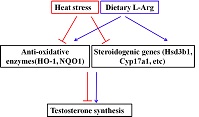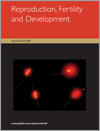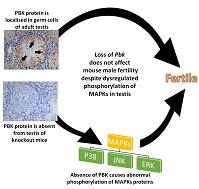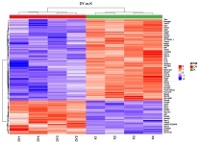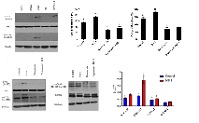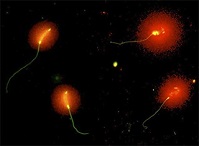Reproduction, Fertility and Development
Volume 32
Number 10 2020
Transient high temperature reduces serum testosterone concentrations by disrupting Leydig cell function. Reduced serum testosterone concentrations in heat-treated mice were normalised by pretreatment with dietary L-arginine, which enhanced LH secretion and testicular expression of steroidogenesis-related genes. Dietary L-arginine supplementation is a good strategy to protect the male reproductive system against hot environments in both animals and humans.
PDZ-binding kinase (PBK) protein is expressed exclusively in germ cells of the adult testis, suggesting its critical role in male fertility. However, its role in male fertility remains unknown. The absence of Pbk from mouse testis did not affect male fertility despite the abnormal phosphorylation of mitogen-activated protein kinases (MAPKs), proteins responsible for major cellular responses and functions. It is possible that the functional redundancy of PBK and overlapping substrate specificities of the MAPK superfamily compensated for the loss of Pbk from the mouse testis.
Oestrogens are known to regulate reproductive functions in males and oestrogen deficiency may lead to various reproductive disturbances, some as severe as infertility. This study investigated the effects of disrupting non-classical oestrogen signalling on the mouse testicular transcriptome. The results provide a new insight into the genes and processes mediated by oestrogens.
This study focused on two critical points in the reproduction and development field: the broad environmental exposure of the general population to MeHg and polychlorinated biphenyls (PCBs) simultaneously, together with the importance of studies using experimental models mimicking the exposure of children. For the first time, chromatoid bodies (molecular regulators of mammalian spermatogenesis) were considered as a biomarker for reproductive toxicological damage.
In a colony of Damaraland mole-rats only one female can reproduce and the other adult females are prevented from ovulating. These non-reproductive females have fatty livers, but if they undergo ovulation, the fat deposits disappear. We suggest that changes in levels of oxidative stress and hormonal changes associated with ovulation are linked with patterns of fat accumulation in the liver.
The role of insulin-like growth factor (IGF) 1 in promoting Sertoli cell proliferation has been reported, but the downstream signalling mechanisms remain unclear. We investigated IGF1 signalling in Sertoli cells and confirmed the role of phosphatidylinositol 3-kinase/Akt/mammalian target of rapamycin signalling in IGF1-mediated Sertoli cell proliferation, and the role of IGF1 in mediating cholesterol biosynthesis in Sertoli cells. These results indicate the different roles IGF1 has in promoting testes growth during early postnatal life in livestock.
Polyspermic penetration occurs at an unusually high rate in pig oocytes and decreases the efficiency of in vitro-produced embryos. We investigated the effects of increasing the perivitelline space thickness during oocyte maturation and found that through supplementation of perivitelline space components, polyspermic penetration decreased. This has important implications for the study of IVF and embryo development in pigs.
Sperm DNA fragmentation (SDF) is becoming an increasingly important measure of male fertility in human medicine and domestic animal production, but its use in bird reproduction is virtually non-existent. We report for the first time an easy-to-use, reliable approach for the measurement of avian SDF using frozen–thawed rooster, turkey and cockatiel spermatozoa. The sperm chromatin dispersion assay described herein will be a vital tool in the assessment of male fertility and evaluation of sperm preservation for reproductive management of poultry, aviculture and the conservation of endangered bird species.
